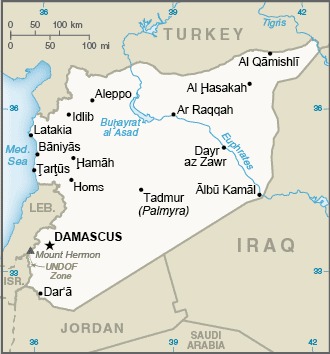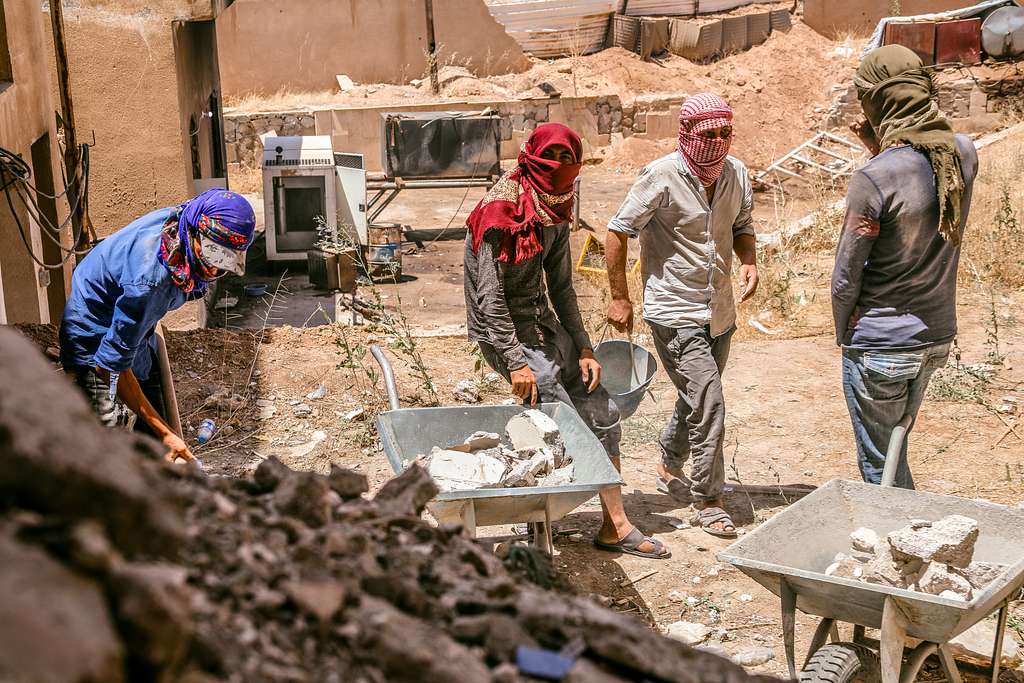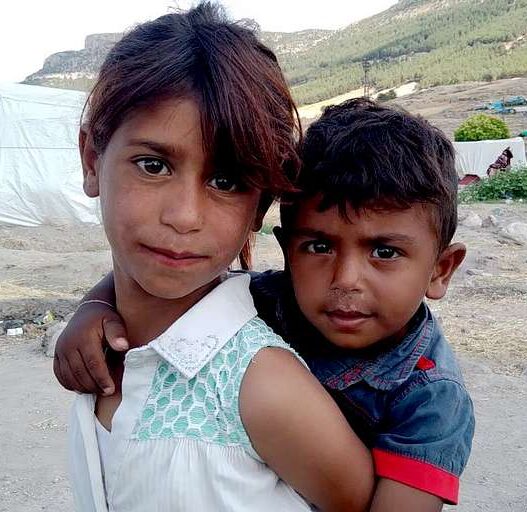Syria
Where
Syria, located in the Middle East, is roughly the size of Oklahoma with more than four times the population. The capital is Damascus, home to 2.7 million people. [1] The country is bordered by Turkey, Iraq, Jordan, Israel, and Lebanon. [2]
When and Why
Drought
In 2006, Syria experienced its worst drought on record. Herders in northeast Syria lost 85% of their livestock, and 75% of farmers experienced total crop loss. One expert called it “the worst long-term drought and most severe set of crop failures since agricultural civilizations began in the Fertile Crescent many millennia ago.” [3] Food prices skyrocketed, and people were starving. Nearly 2 million Syrians who relied on agriculture for food or income lost their livelihoods. Over 1.5 million people were forced to leave their homes and migrate to cities in search of work. [4] Syria’s major cities were already experiencing overcrowding from a previous influx of as many as 1.5 million Iraqi refugees [5] and a population that grew by nearly 40% from 2000 to 2015.
Arab Spring
In 2011, the Arab Spring, pro-democracy uprisings, erupted throughout the Middle East and Northern Africa. The uprisings started in Tunisia and quickly spread to Morocco, Syria, Libya, Egypt, and Bahrain. [6] These movements emphasized a need for greater political freedom, an end to the authoritarian regimes in the region, and economic reform.

Protests in Damascus, 2011. Image courtesy of syriana2011 is cropped and licensed under CC BY 2.0.
In March of 2011, the Arab Spring reached Syria when a group of 15 schoolchildren who had written anti-government graffiti were arrested and tortured. [7] This event highlighted a growing anger with the Bashar al-Assad regime. In response, locals took to the streets to protest, asking for the release of the children, for democracy, and for greater freedom for the people. The government responded with force, killing four protesters. [8] The next day, government troops shot at mourners at the youths’ funerals, killing one more person. This violence fueled unrest, resulting in more protests across the country. Security forces cracked down on demonstrations and killed at least 100 people. [9]
Syrian security forces conducted raids in Homs, Damascus, Daraa, and other cities to extinguish protests. [8] The regime used increasingly brutal tactics, including live ammunition against civilians and mass arrests in attempts to quiet protests. People wanted democracy and they wanted food. Food prices were still rising and the people were still hungry. The government continued to respond with violence, setting the stage for civil war.
The Arab League attempted to mediate the war in 2011 by requiring Syria to hold democratic elections by 2014, end attacks on civilians, and pay reparations to victims. The Arab League called on Syria to implement a peace plan and ultimately suspended Syria’s membership in the League for failure to do so. [10]
Civil War
When the Syrian government used violence to crack down on protests, citizens began arming themselves, and rebel brigades formed to fight the government for control of cities. By 2012, armed groups were battling for essential urban centers including Damascus and Aleppo. [12] In December 2012, the Assad regime carried out the first of many chemical weapons attacks, killing women and children and sparking international condemnation. [13] In August the following year, a Syrian chemical weapons attack killed of 1,700 civilians. [14] The act crossed what President Obama declared to be a “red line.” In response to the chemical attack, President Obama entered a three-party deal with Russia under which Syria committed to removing or destroying its chemical stockpile. [14]
The government used barrel bombs on cities, targeted hospitals, arrested and tortured civilians, and used rape and starvation as weapons of war. Food, water, medicine, and electricity were blocked, leaving citizens starving and dying. [13]
Since 2011, over 450 attacks have been made on Syrian hospitals and over 800 medical professionals have been killed. [15] So many doctors have been killed or have fled that veterinarians and dentists are often forced to perform surgeries. Organizations like the Syrian American Medical Society (SAMS) have built underground hospitals to provide services despite the bombings. SAMS has spent more than $3.5 million on underground cave hospitals. Over only six years of war, the organization’s staff delivered 100,000 babies and supported nearly 400,000 surgeries. [15]
Other Players
The extremist group Islamic State in Iraq in Syria (ISIS) took advantage of Syria’s instability and emerged in Syria in 2013 with the goal of establishing a caliphate, or a Muslim state governed under Islamic law. ISIS quickly took control of eastern territories not under government control and established its own capital in the Syrian city of Raqqa. [16] ISIS became internationally recognized through their violent propaganda videos of public beheadings, crucifixions, and mass executions. They are an ultra-radical Sunni Muslim group that has targeted Shia Muslims, moderate Sunnis, and religious minorities like Yazidi Christians. Although many westerners think the Syrian conflict revolves around ISIS, the Syrian government and its allies are ultimately responsible for nearly all the Syrian casualties. [17]
The Kurds are an ethnic minority that has lived in Turkey, Syria, and Iraq since ancient Mesopotamia. They have been fighting for an independent state since the region broke apart in the 1900s. They want their own state, or at least control over their region. [18] The US has supported Kurdish forces with weapons and training, and the Kurds have been successful in fighting ISIS and Assad in the north. [19]
Hezbollah, a Shiite Muslim militant group in Lebanon, is in alliance with the Assad regime. [20] The group has been openly involved in the Syrian Civil War since 2013, when they sent thousands of militants to fight alongside the Iranian and Russian forces supporting the Syrian government. The group began to withdraw from the region in 2019, saying that Assad’s regime had been militarily successful. Syria is credited with strengthening the military force of Hezbollah. [21]
Displacement Crisis
An estimated half a million people have been killed since the war began; 6.7 million refugees have fled their homes for other countries; and 7.2 million people are internally displaced within Syria. [22] Half of those affected are children, and one out of four displaced persons on the planet is Syrian. This is the greatest refugee crisis the world has seen since World War II. [23]
Syrians fled to five main countries: Turkey, Lebanon, Jordan, Iraq, and Egypt. [23] The influx of refugees placed immense stress on governments without the infrastructure or wealth to support such large refugee populations. Turkey, Jordan, and Lebanon now prevent Syrians from seeking asylum at their borders. [24] More than a million Syrian refugees are registered with United Nations High Commissioner for Refugees. [25] Seventy-four percent of Syrians in Lebanon lack legal residency and risk detention for being in the country unlawfully, and in 2017, Lebanese authorities called for refugees to return to Syria. Some refugees are returning because of harsh policies and deteriorating conditions in Lebanon, and cities have forcibly evicted thousands of refugees in mass expulsions without a legal basis while tens of thousands remain at risk of eviction. [25]
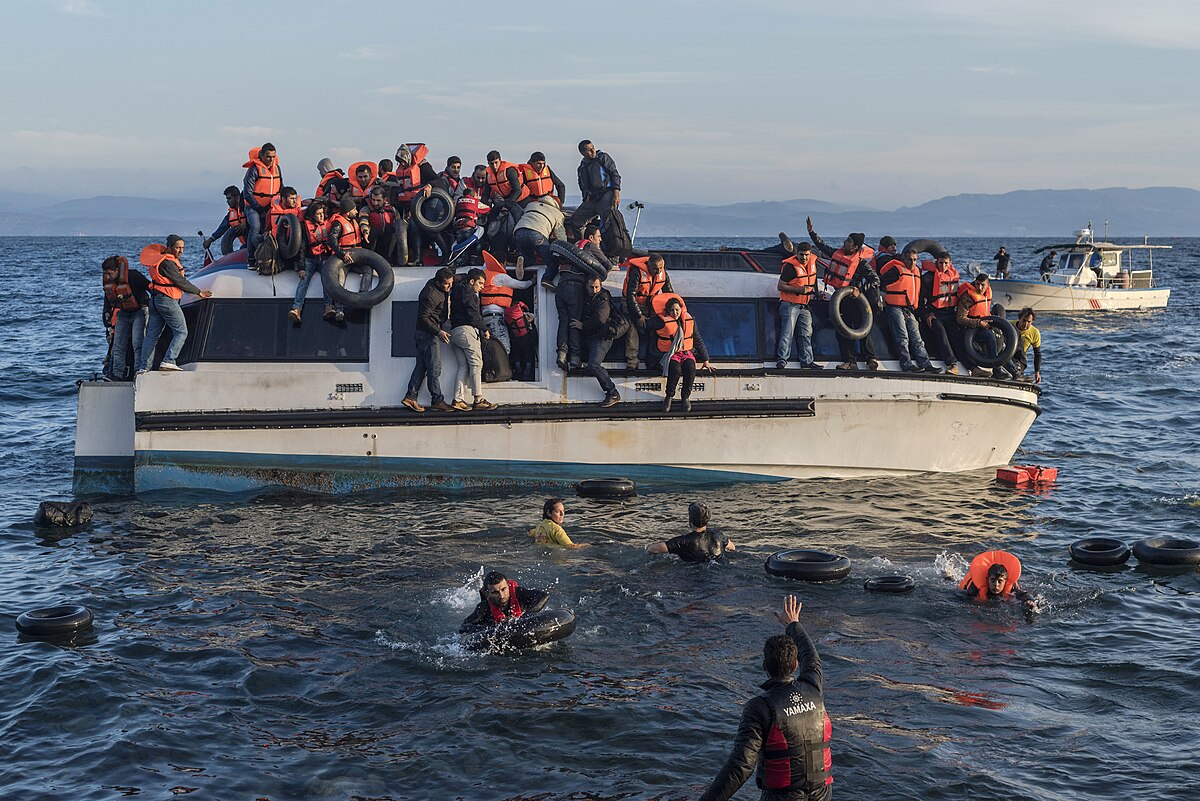
Many Syrians take dangerous boat crossings to escape Syria. Image courtesy of Ggia is unmodified and licensed under CC BY-SA 4.0.
As of 2018, Turkey registered approximately 3.6 million refugees, about the population of Los Angeles. Turkey stated it will not open its border to asylum seekers fleeing hostilities. Instead, Turkish authorities opened several displaced persons’ camps in areas under their control in Syria. [25] Desperate families have also tried to flee to Europe, risking their lives as they cross the Mediterranean Sea in small, overcrowded boats. In 2016, over 360,000 refugees crossed the Mediterranean into Europe. Nearly 4,000 people died on the way. [26]
Syrian refugees also traveled across the Atlantic to the United States and Canada. The Trump administration restricted the number of refugees the US accepts each year. [27] The US took in 12,587 Syrian refugees in 2016 and 6,587 in 2017, a decline of nearly half. Restrictions drastically increased and the US took in only 62 Syrians in 2018. [28] In the fiscal year 2022, 4,556 refugees from Syria were admitted into the US, an increase from 2021, when 1,246 Syrian refugees were admitted. [29]
Most Syrian refugees in neighboring countries live in urban areas and 8% live in refugee camps. [30] Refugees face overwhelming challenges. They left everything, and many arrived with only the clothes on their backs. Most Syrian refugees are living well below the poverty line. Language barriers and the need to earn money often prevent refugee children from getting an education. Child marriage has also increased in refugee communities and poverty-stricken parents marry off daughters to afford to feed the rest of their families. [31] Parents also often believe their daughters will be safer with a husband to protect them.
Proxy War
Despite the Syrian civilian uprising, President Assad has stayed in power and is now devastating the civilian rebel forces. This would not have been possible without the Syrian government’s greatest ally, Russia. Syria and Russia have been allies since the Cold War. Russia has military bases in Syria and sells $1.5 billion worth of weapons to Syria each year, about 10% of Russian global weapons sales. [32]
The Syrian war has turned into a proxy war, or a war instigated by major powers that are not directly involved in the combat. [33] The US supports rebel groups fighting Assad and ISIS, and Russia supports Assad against ISIS, the rebels, and in turn, civilians. Russia has been criticized for its role in civilian attacks and for aiding a regime that uses chemical and other internationally banned weapons against its own citizens.
Russia has a permanent seat on the UN Security Council and has used its veto power to prevent UN action to address the conflict. Resolutions vetoed by Russia include calls for sanctions, ceasefires, investigations into chemical weapons use, and a proposal to refer Syrian war crimes to the International Criminal Court (ICC). [34]
The Trump administration took a hardline approach to the Syrian government’s chemical attacks. After a chemical attack in April 2017, the US fired 59 Tomahawk missiles at a Syrian air base. An April 2018 Syrian chemical attack which killed 48 people was met with a coordinated military effort from the US, France, and Britain on three chemical weapons facilities. [35]
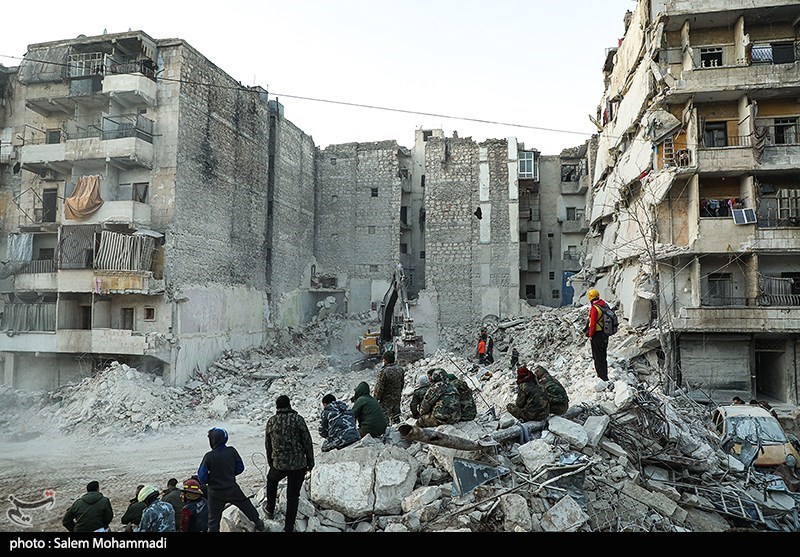
Aleppo after 7.8 magnitude earthquake struck southern Turkey and northern Syria, 2023. Image courtesy of Tasnim News Agency is unmodified and licensed under CC BY 4.0.
Earthquake
In February 2023, two earthquakes and their aftershocks struck southern Turkey and northwest Syria. This worsened conditions for the displaced population. The earthquake caused an increase in hunger levels and malnutrition in the region, and limited access to healthcare and educational support. Current death toll estimates remain under 60,000 casualties in total, with 8,400 of those being in Syria. The Syrian Civil War has impeded relief efforts significantly, with the situation being described as a “catastrophe on top of catastrophe” by the head of the World Food Programme. [36]
The World Food Programme estimates that $150 million is needed to support those affected by the earthquake for 6 months. [36] Almost a year and a half later, reconstruction efforts are slow despite the generous international response. In Syria, one in three children was displaced by the earthquake and remain homeless. The socioeconomic status of the region was deteriorating, which was worsened by the earthquake. [37]
Justice
Efforts to bring victims justice and hold perpetrators accountable have already begun. European authorities have opened investigations into war crimes committed in Syria, with Sweden and Germany as the first two countries to convict perpetrators. However, justice is difficult to obtain. Without access to crime scenes for evidence, authorities must rely on NGOs, UN entities, and refugees and asylum seekers, many of whom fear retribution against loved ones in Syria and distrust government officials because of their experiences in Syria. [38]
A case against the Assad regime has been building based on tens of thousands of photos documenting torture which were smuggled out of Syria by a military defector. The photos have aided court cases in Spain, Germany, and France. [39] The evidence against the Assad regime, according to former US Ambassador-at-Large for War Crimes Stephen Rapp, “is massive and overwhelming, far better than they had at Nuremberg or in The Hague at the Yugoslavia tribunal or that we had in Sierra Leone or the genocide trials against the Rwandan leaders.” [40]
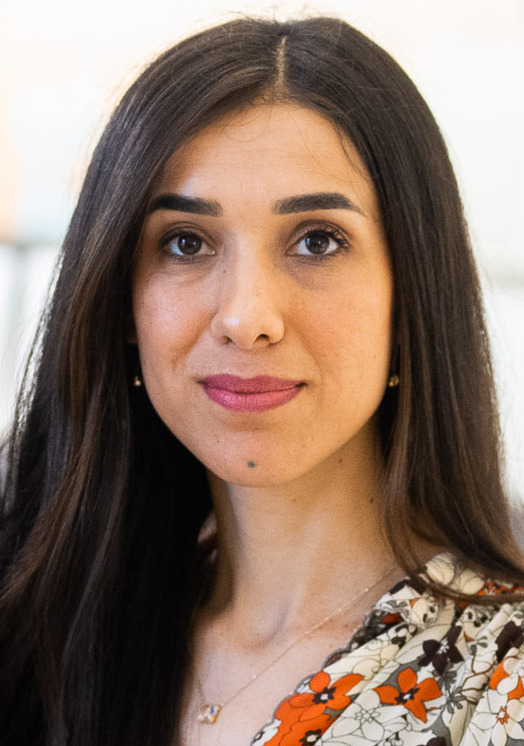
Nadia Murad. Image courtesy of Bundesministerium für europäische und internationale Angelegenheiten is unmodified and licensed under CC BY 2.0.
There are also efforts to prosecute violence committed by ISIS. Human rights lawyer Amal Clooney has taken legal action against ISIS for their efforts to commit genocide against the Yazidi people. Her client, Nadia Murad, was captured by ISIS in 2014 and escaped three months later after surviving repeated rapes. Murad’s mother and six brothers were killed. [41] Clooney hopes to get the case referred to the International Criminal Court.
The government of Qatar approached leading human rights investigators in 2014 to authenticate photos taken by a defector from Syria and to determine whether the evidence indicated commission of international crimes. The defector was given the name Caesar to protect his identity. Caesar’s journey started in 2011 as a forensic photographer in the Syrian army and his job was to photograph deceased individuals at a military hospital near Damascus. He became concerned with the deaths as the number steadily increased and the condition of the dead bodies became more visibly suggestive of torture. He smuggled copies of the photographs onto a memory stick, and over the next two years he smuggled out 54,000 photos of 11,000 bodies. [39]
In 2013, Caesar fled, and he now endeavors to seek international support on behalf of the Syrian people. On March 11, 2020, Caesar testified at the Senate Foreign Relations Committee about the war in Syria, following which the United States committed an additional $108 million to humanitarian assistance. [40] The National Defense Authorization Act of 2020 included a section titled “Caesar,” based almost entirely on Caesar’s 2014 testimony to Congress. This act finally placed sanctions on Syria. [41]
Today
In 2024, Syria remans embroiled in civil war, with humanitarian conditions worsening. Violent clashes continue between the Assad regime, Kurdish forces, and regional opposition groups. [42] Russia and Iran’s military forces continue to support the Assad regime, and the US keeps troops in northeastern Syria in attempts to counter ISIS influence.
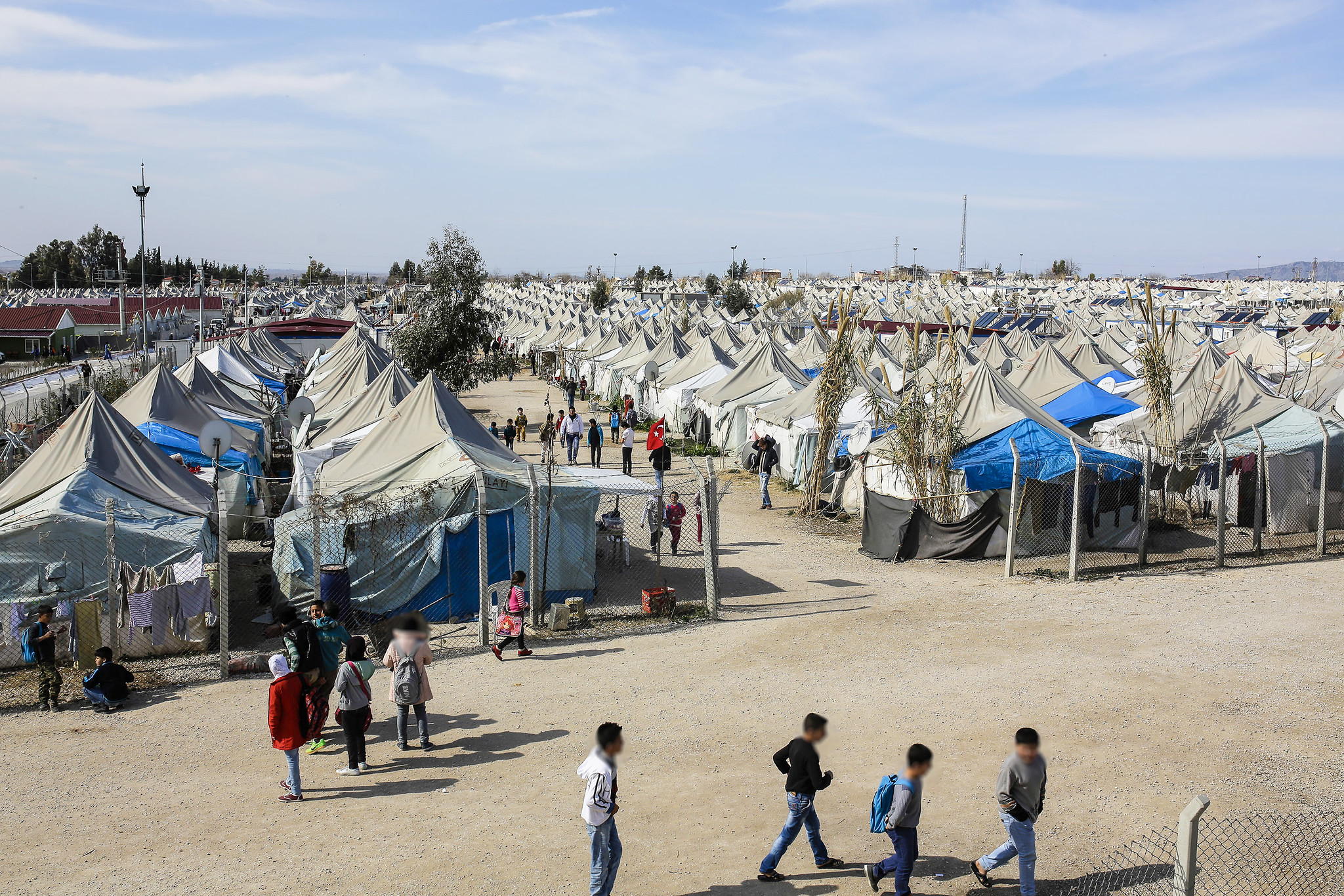
Syrian refugee camp in neighboring Turkey. Image courtesy of European Parliament is unmodified and licensed under CC BY-NC-ND 2.0.
An estimated 16.7 million people need emergency aid. More than half of the population in Syria is displaced, with 6.5 million being recognized as refugees and asylum seekers. Humanitarian efforts are desperately needed. Fully 47% of Syrian refugees are children, and one-third of them lack access to education. The UN Refugee Agency estimates that 90% of the population lives below the poverty line. [23]
Northeastern Syria, dominated by the Kurds, remains under the control of Syrian Defense Forces (SDF). Arab tribes accuse the SDF of discrimination. [43] Turkey maintains control along the northern border and have increased their attacks on Kurdish forces. The Israel-Palestine conflict resulted in increased strikes in Syria. Israel now regularly strikes different military positions in Syria, including the Damascus and Aleppo airports.
International attention has begun to shift away from the region. President Assad holds 70% of Syria’s territory and has become reintegrated into Arab League, effectively ending his previous isolation. [43] Despite the waning media attention, the Syrian conflict remains one of the worst humanitarian crises of the 21st century. The international community must end impunity for the Assad regime’s human rights abuses and aid in the reconstruction and distribution of aid throughout the region.
Updated by Evelyn Middleton, October 2024.
References
[1] World Population Review. (2024). Damascus, Syria Population, 2024. World Population Review. https://worldpopulationreview.com/cities/syria/damascus
[2] The World Factbook. (2024, October 8). Syria. CIA. https://www.cia.gov/the-world-factbook/countries/syria/
[3] Reuters. (2018, March 12). Syrian Observatory says war has killed more than half a million. Reuters. https://www.reuters.com/article/us-mideast-crisis-syria/syrian-observatory-says-war-has-killed-more-than-half-a-million-idUSKCN1GO13M
[4] Mansharamani, V. (2016, March 17). A major contributor to the Syrian conflict? Climate change. PBS News. https://www.pbs.org/newshour/economy/a-major-contributor-to-the-syrian-conflict-climate-change
[5] al-Khalidi, A., Hoffman, S. & Tanner, V. (2007, June). Iraqi Refugees in the Syrian Arab Republic: A Field-Based Snapshot. The Brookings Institution – University of Bern. https://www.brookings.edu/wp-content/uploads/2016/06/0611humanrights_alkhalidi.pdf
[6] History.com. (2020, January 17). Arab Spring. History. https://www.history.com/topics/middle-east/arab-spring
[7] Tarabay, J. (2018, March 15). For many Syrians, the story of the war began with graffiti in Dara’a. CNN. https://www.cnn.com/2018/03/15/middleeast/daraa-syria-seven-years-on-intl/index.html
[8] Yacoubian, M. (2021, January 1). Syria Timeline: Since the Uprising Against Assad. United States Institute of Peace. https://www.bbc.com/news/world-middle-east-26116868
[9] Human Rights Watch. (2011, March 21). Syria: Government Crackdown Leads to Protester Deaths. Human Rights Watch. https://www.hrw.org/news/2011/03/21/syria-government-crackdown-leads-protester-deaths
[10] Arab League decides to suspend Syria. Aljazeera. (2011, November 13). https://www.aljazeera.com/news/2011/11/13/arab-league-decides-to-suspend-syria/
[11] Britannica. (2024, August 17). Syrian Civil War. Britannica. https://www.britannica.com/event/Syrian-Civil-War
[12] Arms Control Association. (2023, October). Timeline of Syrian Chemical Weapons Activity, 2012-2022. Arms Control Association. https://www.armscontrol.org/factsheets/timeline-syrian-chemical-weapons-activity-2012-2022
[13] Human Rights Council. (2014, February 12). Report of the independent international commission of inquiry on the Syrian Arab Republic. United Nations General Assembly. https://documents.un.org/doc/undoc/gen/g14/109/24/pdf/g1410924.pdf
[14] Romero, D. (2018, April 13). From Arab Spring to chemical attacks: A timeline of the Syrian conflict and the U.S. response. NBC News. https://www.nbcnews.com/news/us-news/arab-spring-chemical-attacks-timeline-syrian-conflict-n865961
[15] Pelley, S. (2017, November 26). When hospitals become targets. CBS News. https://www.cbsnews.com/news/when-hospitals-become-targets/
[16] Britannica. (2024, October 11). Islamic State in Iraq and the Levant. Britannica. https://www.britannica.com/topic/Islamic-State-in-Iraq-and-the-Levant
[17] Reuters. (2018, March 12). Syrian Observatory says war has killed more than half a million. Reuters. https://www.reuters.com/article/us-mideast-crisis-syria/syrian-observatory-says-war-has-killed-more-than-half-a-million-idUSKCN1GO13M
[18] BBC. (2019, October 15). Who are the Kurds? BBC. https://www.bbc.com/news/world-middle-east-29702440
[19] Steward, P. (2017, May 30). U.S. starts providing weapons to Syrian Kurds. Reuters. https://www.reuters.com/article/world/us-starts-providing-weapons-to-syrian-kurds-idUSKBN18R038/
[20] Robinson, K. (2024, October 4). What Is Hezbollah? Council on Foreign Relations. https://www.cfr.org/backgrounder/what-hezbollah
[21] Robinson, K. (2024, July 30). What is Hezbollah?. Council on Foreign Relations. https://www.cfr.org/backgrounder/what-hezbollah
[22] Staff, W. V. (2024, July 15). Syrian refugee crisis: Facts, faqs, and how to help. https://www.worldvision.org/refugees-news-stories/syrian-refugee-crisis-facts#:~:text=As%20of%20June%202024%2C%20Syria,within%20and%20outside%20its%20borders
[23] USA for UNHCR. (2024, March 13). Syria Refugee Crisis Explained. USA for UNHCR. https://www.unrefugees.org/news/syria-refugee-crisis-explained/
[24] Human Rights Watch. (2021, October 20). “Our Lives Are Like Death,” Syrian Refugee Returns from Lebanon and Jordan. Human Rights Watch. https://www.hrw.org/report/2021/10/20/our-lives-are-death/syrian-refugee-returns-lebanon-and-jordan
[25] Human Rights Watch. (n.d.). Syria, Events of 2018. Human Rights Watch. https://www.hrw.org/world-report/2019/country-chapters/syria
[26] UNHCR. (2016, December). Refugees & Migrants Sea Arrivals in Europe. UNHCR, Bureau for Europe. https://data2.unhcr.org/ar/documents/download/53447
[27] Reuters. (2020, October 28). Trump administration sets record low limit for new U.S. refugees. Reuters. https://www.reuters.com/article/world/trump-administration-sets-record-low-limit-for-new-us-refugees-idUSKBN27D1UG/
[28] Todd, Z. (2019, November 19). By the Numbers: Syrian Refugees Around the World. PBS Frontline. https://www.pbs.org/wgbh/frontline/article/numbers-syrian-refugees-around-world/
[29] Korhonen, V. (2024, July 5). Syrian refugee arrivals in the United States from FY 2011 to September 30, 2022. Statista. https://www.statista.com/statistics/742553/syrian-refugee-arrivals-us/
[30] UNHCR. (2023, August). Syria emergency. UNHCR. http://www.unhcr.org/en-us/syria-emergency.html
[31] Amanpour, C. (2017, August 9). The Desperate Struggle for Home at the U.N.’s Largest Syrian Refugee Camp. Vanity Fair. https://www.vanityfair.com/news/2017/08/the-desperate-struggle-for-home-at-the-uns-largest-syrian-refugee-camp
[32] Trenin, D. (2012, February 9). Why Russia Supports Assad. The New York Times. https://www.nytimes.com/2012/02/10/opinion/why-russia-supports-assad.html?_r=2&emc=rss&partner=rss
[33] van der Meer, D. (2020). The Syrian Proxy War. Leiden University. https://studenttheses.universiteitleiden.nl/access/item%3A3190945/view
[34] RTÉ. (2018, April 11). Russia’s 12 UN vetoes on Syria. RTÉ. https://www.rte.ie/news/world/2018/0411/953637-russia-syria-un-veto/
[35] Cooper, H., Gibbons-Neff, T. & Hubbard, B. (2018, April 13). U.S., Britain and France Strike Syria Over Suspected Chemical Weapons Attack. The New York Times. https://www.nytimes.com/2018/04/13/world/middleeast/trump-strikes-syria-attack.html
[36] WFP executive director shocked by apocalyptic devastation across Turkiye and Syria during visit, calls for Global Support: World Food Programme. UN World Food Programme. (2023, February 25). https://www.wfp.org/news/wfp-executive-director-shocked-apocalyptic-devastation-across-turkiye-and-syria-during-visit
[37] 2023 Turkey-Syria earthquake. Center for Disaster Philanthropy. (2024, April 25). https://disasterphilanthropy.org/disasters/2023-turkey-syria-earthquake/
[38] Human Rights Watch. (2017, October 3). Syria: First Atrocities Trials Held in Europe. Human Rights Watch. https://www.hrw.org/news/2017/10/03/syria-first-atrocities-trials-held-europe
[39] Bowman, T. (2014, July 29). For Two Years, He Smuggled Photos Of Torture Victims Out Of Syria. NPR. https://www.npr.org/2014/07/29/336228277/photos-from-syria-may-show-killing-on-an-industrial-scale
[40] Araujo, M. & Shelley, J. (2017, March 21). Syrian defector to Trump: Stop Assad’s machinery of death. CNN. https://www.cnn.com/2017/03/21/middleeast/caesar-syria-torture-amanpour-interview/index.html
[41] McFadden, C., Whitman, J. & Rappleye, H. (2016, September 19). Amal Clooney Takes on ISIS for ‘Clear Case of Genocide’ of Yazidis. NBC News. https://www.nbcnews.com/storyline/isis-uncovered/amal-clooney-takes-isis-clear-case-genocide-yazidis-n649126
[42] Meetings Coverage and Press Releases. (2024, August 28). Tensions in Syria, Region ‘Have Reached Dangerous New Levels’, Special Envoy Warns Security Council, Calling for Inclusive Political Process. United Nations, Meetings Coverage and Press Releases. https://press.un.org/en/2024/sc15802.doc.htm
[43] Council on Foreign Relations. (2024, February 13). Conflict in Syria | Global Conflict Tracker. Council on Foreign Relations. https://www.cfr.org/global-conflict-tracker/conflict/conflict-syria



